POSTCARDS FROM BELIZE
February 14–23, 2003
Our first trip to Belize (April, 2000) is posted on
another web page. On that
trip Judy and I spent a week on an Elderhostel Service Trip to Spanish Lookout Caye
and additional time at Hidden Valley Inn
in the Mountain Pine Ridge area on the western side of the country. We so enjoyed the
country and the people that we thought it would be a perfect place for a family vacation.
We began planning a year ago: four days in the jungle near
the western town of San Ignacio,
about 10 miles from the Guatemala border, and five days in
San Pedro on Ambergris Caye.
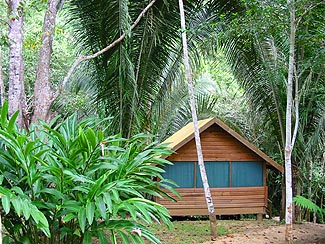 MACAL RIVER JUNGLE CAMP
MACAL RIVER JUNGLE CAMP
We were picked up at Belize International Airport and driven a long 75
miles on the Western Highway to San Ignacio, then south a few miles to the
Lodge at Chaa Creek Lodge which also runs
the Jungle Camp on the Macal River, a half
mile from the main reception area.
We stayed in four of the ten screened “casitas”
 amidst thick jungle just above the river. (Michael and Cindy’s casita was the one you see
“behind the palm fronds” on
the web site for the Camp.) We ate breakfast and dinner each day in the open air dining area
and enjoyed a campfire each night. The flush toilets and hot showers were a greatly appreciated
touch of civilization. We were very comfortable, ate well, and drank very cold sodas and
Belikins. Dosio, his
wife, Francelia, and a small staff provided for our every comfort and helped make arrangements
for our daily activities.
amidst thick jungle just above the river. (Michael and Cindy’s casita was the one you see
“behind the palm fronds” on
the web site for the Camp.) We ate breakfast and dinner each day in the open air dining area
and enjoyed a campfire each night. The flush toilets and hot showers were a greatly appreciated
touch of civilization. We were very comfortable, ate well, and drank very cold sodas and
Belikins. Dosio, his
wife, Francelia, and a small staff provided for our every comfort and helped make arrangements
for our daily activities.
 Day 1: Canoeing the Macal River to San Ignacio
Day 1: Canoeing the Macal River to San Ignacio
Saturday, our first full day, was market day in San Ignacio. We
rented four canoes and set off (with the current) for the six-mile trip downstream to see the
town. We had been warned the night before by a departing guest of an occasional
“highjacking” of visitors canoeing along the river. Dosio confirmed that it does happen,
but he said we shouldn’t worry about it; let him do the worrying.
We were, I suppose, wary when we saw folks along the river during our
trip, but there were no incidents—unless you call tipping over a canoe an “incident.”
It happened at the very beginning when Hughes tipped over a canoe upon getting in. It did get
Griffin wet, since he was already in, and our digital camera also got soaked, though after 2-3
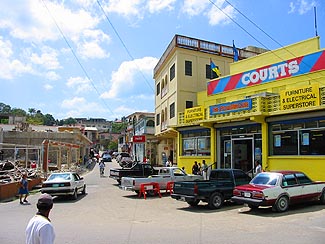 days, it dried and continued to work as though nothing had happened. (Nikons really are good
cameras!)
days, it dried and continued to work as though nothing had happened. (Nikons really are good
cameras!)
The river ran smoothly with only occasional ripples and low overhanging
branches to maneuver around. We saw few signs of wildlife: a few birds, no monkeys, jaguars, or other
large mammals. No bugs at all. After a full day of sitting on planes and vans, the exercise
was a welcome change.
We tied up between bridges in San Ignacio and walked through town and the
market. The weather was, as expected, hot and humid. The market was largely local produce and we bought
only some peanuts (cashews grown locally were not yet in season) and some limes. We had a good lunch at
Hode’s across from the park. It must be good: it’s where the buses stop.
When we were done, we took a cab back to the Jungle Camp where Griffin and
I took a swim in the river followed by sodas and Belikins before dinner.
 Day 2: Barton Creek Cave
Day 2: Barton Creek Cave
The Cayo District has many caves, both dry and wet, that can be explored by
visitors. Some are challenging and others are quite accessible. The
Barton Creek Cave is one of the most
popular wet caves because the first mile or so of the 4.5
miles can be accessed by canoe.
While we were in San Ignacio, we made arrangements for a half day trip
to Barton Creek, which is an hour of combined paved highway and really rough dirt road to reach the cave
entrance. The road took us, as I reminded Griffin, to the middle of nowhere.
Along the way, we passed through an old order Amish settlement. We knew that
there were several successful and prosperous Mennonite communities who had come to Belize generations ago
to farm, but we had not anticipated the more conservative Amish down here living in such an isolated area.
Several miles off the highway (at Georgeville
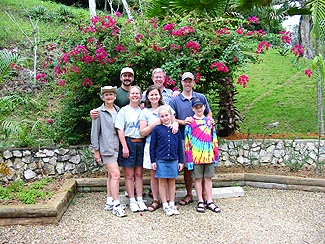 east of San Ignacio) we passed through a huge citrus ranch (oranges and grapefruit) and drove through a
community of small, self-sustaining farms with horses and buggies out front. In the middle of the farms
was a church holding services for families in traditional dress that you expect to see in the Amish areas
of Pennsylvania, Ohio, and Indiana. In the jungles of Belize, it was surprising.
east of San Ignacio) we passed through a huge citrus ranch (oranges and grapefruit) and drove through a
community of small, self-sustaining farms with horses and buggies out front. In the middle of the farms
was a church holding services for families in traditional dress that you expect to see in the Amish areas
of Pennsylvania, Ohio, and Indiana. In the jungles of Belize, it was surprising.
At the end of the road was a house, some cars (one with Ontario license plates),
and a hut where we got our canoes, paddles, life jackets, and flashlights. Our “guide,” a pleasant
and experienced fellow, but not particularly chatty, led our three canoes into the quiet of the cave, under
low overhangs and through narrow channels to where we couldn’t go farther (we were not prepared to swim
or scuba beyond). We saw many formations of stalactites and stalagmites—and bats—but, unfortunately,
we learned little about the Maya’s ritual use of the cave and their beliefs about the underworld.
On the return trip, we stopped at the Maya Ranch, a restaurant run by the
Janus Foundation, for homemade ice
cream (including a sundae called “Hot Love”) and bakery items. Like the Amish community, this
business operates in an isolated area south of Georgeville. It was another pleasant surprise along the way.
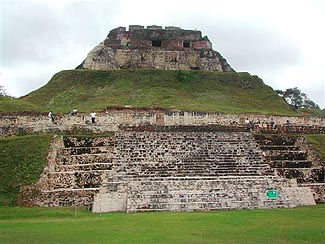 Day 3: Bicycling to Xunantunich and More
Day 3: Bicycling to Xunantunich and More
Not more than 5-6 miles from the Jungle Camp is
Xunantunich, an imposing Maya site
near the village of San Jose Succotz. We thought it would be a reasonable destination for a group bike trip.
There were, unfortunately, no bikes to fit the grandchildren, and we did not count on hilly terrain that was
more challenging than most of the adults wanted to attempt. The result was that Dan and I made the trip,
while the others relaxed at the camp.
The trip combined three miles of hilly dirt road from the camp to the paved
highway, two miles south to San Jose Succotz, a river crossing via a hand-cranked ferry, and a challenging
uphill ride to the site of this Mayan ceremonial site. Dan and I walked the small area of four main buildings
that are still undergoing reconstruction. From the top of the 130 foot high “El Castillo” (The
Castle) we had an uninterrupted view
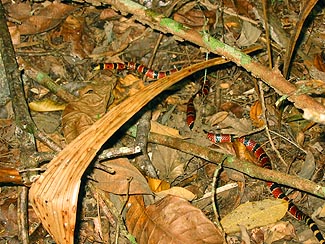 of Guatemala and nearly back to San Ignacio.
of Guatemala and nearly back to San Ignacio.
After lunch at the Chaa Creek Lodge restaurant/bar, we hiked the trails on the
grounds of Lodge to visit their Natural History Center and Butterfly Farm, where we saw how they raised
spectacular Blue Morpho
butterflies that are native to the rain forests of Central and South America. (You can take a virtual
tour of the property at Chaa Creek by clicking
here. The Jungle Camp is identified as “campground.”)
Did we see any dangerous critters? How were the mosquitoes? Did anyone get sick?
The answers are yes, didn’t see or hear any, and not really. Specifically, Michael and Cindy caught a
good sized scorpion in their casita and, while hiking, managed to see and photograph this two-step coral
snake (two steps after he bites you, you die—or so goes a common saying). Whatever the length of time is,
coral snakes are highly
venomous and the scorpions are big (4"-6",) and the one they caught was big. We didn’t see or hear or get
bitten by mosquitoes. There were some no-see’um like biting insects along the beach in San Pedro; Judy
came back with the itches. As for sickness, read the account of the diving on Day 8.
 Day 4: The Belize Zoo and a
Boat Ride to Ambergris Caye
Day 4: The Belize Zoo and a
Boat Ride to Ambergris Caye
We left the Jungle Camp mid morning and drove about an hour to the
Belize Zoo which is on the Western
Highway about 30 miles from Belize City. It is small, yet it is home to most of the mammals, reptiles,
and many of the larger birds that are native to Belize. Each is there because it was abandoned, injured,
donated, or orphaned. The tapir, (that’s April, snoozing in the photo on the left) is the national
animal of Belize. It takes perhaps an hour to see animals that one
rarely is able to see in the wild (e.g., jaguars, peccaries, tapirs, et al.). The hand-lettered signs are
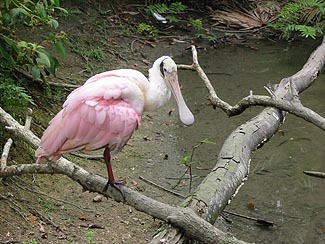 worth the price of admission. Nearby are two restaurants worth stopping at for lunch: Cheers (with scores
of T-shirts hanging from the ceiling) and
JB’s where we stopped.
worth the price of admission. Nearby are two restaurants worth stopping at for lunch: Cheers (with scores
of T-shirts hanging from the ceiling) and
JB’s where we stopped.
On to Belize City where, with the help of Ian, our driver/guide, we were able to
get on a fully loaded water taxi for the 75 minute ride from Belize City to San Pedro. The rain we had during
the trip from the zoo to Belize City began again half way to San Pedro. Because the water taxi was an open
boat, the captain called for a large tarp brought out to cover the 50 or so passengers who had to hold the
tarp down against the wind of the moving boat. The rain was over by the time we reached San Pedro and we
arrived at the Banana Beach Resort fairly dry, though
the streets of town, none of which are paved, were puddled and muddy.
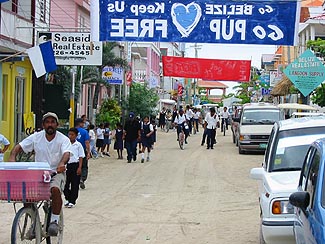 Day 5: Exploring San Pedro
Day 5: Exploring San Pedro
Banana Beach is a little over a mile south of
downtown San Pedro,
the only town on Ambergris Caye (population about 7,000). Almost everything in the town and on the island
is focused on water sports. Diving the second longest reef in the world is world class, and the snorkeling
is equally good. The local fishermen have discovered they can make many times more income from leading sport
fishing trips as they could from catching fish themselves. Windsurfing, sailing, manatee watching trips, and
cruises are also popular.
The beaches vary from very narrow strips
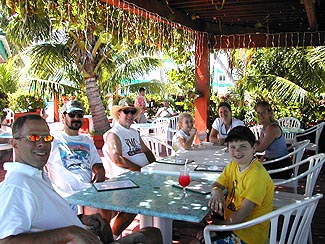 of sand like the one in front of Banana Beach to wide, clean white sand beaches like those in front of
isolated Captain Morgan’s Retreat, the
posh Victoria House, and the good looking
Villas at Banyan Bay. However,
narrow beach or wide, we were able to walk to town along the shoreline, passing more diving docks than
I’ve seen on any beach anywhere, some restaurants on piers over the water, large resorts and small
hotels, and private beach front homes all the way to town. We looked through shops in town and did some
food shopping for breakfasts and snacks.
of sand like the one in front of Banana Beach to wide, clean white sand beaches like those in front of
isolated Captain Morgan’s Retreat, the
posh Victoria House, and the good looking
Villas at Banyan Bay. However,
narrow beach or wide, we were able to walk to town along the shoreline, passing more diving docks than
I’ve seen on any beach anywhere, some restaurants on piers over the water, large resorts and small
hotels, and private beach front homes all the way to town. We looked through shops in town and did some
food shopping for breakfasts and snacks.
We split up on the way back; Judy and I did some grocery shopping and had a
light lunch at Jerry’s Crab
Shack (tasty crab cake sandwiches and cold beer). We spent the afternoon on the beach and, later, we
played some serious Shanghai rummy. (Yes, we had 4 TVs, one in each bedroom and a fourth in the living room,
but only the kids did much TV watching.)
 Day 6: Water Play
Day 6: Water Play
We’ve almost always planned our family vacations around a beach where the
diving and snorkeling are great. Coming to San Pedro was no exception. We signed up with
Barefoot Diving for a half day snorkel/dive
combo trip to Hol Chan and Shark Alley. At Hol Chan,
which is a national marine park, Dan and Hughes did a dive with Adolpho and everyone else snorkeled.
After an hour or so, we moved the boat to Shark Ray Alley where everyone snorkeled. We all saw plenty of
southern sting rays with a “wing” span of 2'–4'
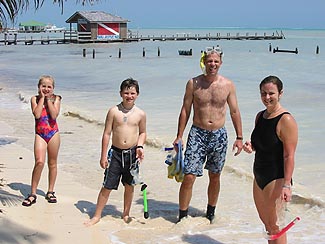 and at least one spotted ray. Michael got a photo of a huge eel and a small nurse shark, as well as barracuda
and schools of smaller fish. Years of fishermen cleaning fish in this shallow are just inside the reef and
throwing the unwanted parts overboard attracted the rays and sharks who have made a habit of coming for food
here. The same happened in Cayman Islands to create Sting Ray City.
and at least one spotted ray. Michael got a photo of a huge eel and a small nurse shark, as well as barracuda
and schools of smaller fish. Years of fishermen cleaning fish in this shallow are just inside the reef and
throwing the unwanted parts overboard attracted the rays and sharks who have made a habit of coming for food
here. The same happened in Cayman Islands to create Sting Ray City.
We had a late lunch at Rico’s just down the beach from us (moderate prices,
great location, and decent food). After some pool and beach time, we snacked our way through dinner and played
more Shanghai rummy.
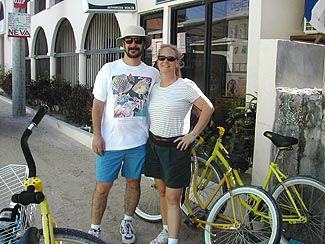 Day 7: Bicycling the Island
Day 7: Bicycling the Island
Unlike the hilly terrain in the San Ignacio area, Ambergris Caye is flat and the
road surfaces are comfortably sandy. We rented bikes, including one that fit our granddaughter, each with fat
tires, one gear, soft seats, and coaster brakes. Some had baskets. I’d forgotten how pleasant and
easy-going bicycle rides could be. There are a few cars, taxis and trucks on the island. Folks either ride
bikes or drive (licensed) golf carts. The pace is slow; no one is in a hurry and anywhere you want to go is
close by.
We rode north through downtown San Pedro, took
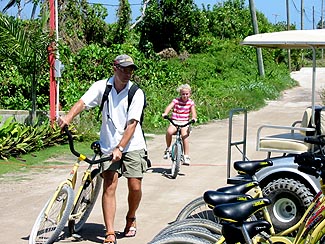 the hand-pulled ferry across a lagoon inlet to the “north side” where the number of homes and
businesses thin out dramatically. We rode about three miles to where the road led to Captain Morgan’s
Retreat after which there’s not much more to see and the road slowly deteriorates.
the hand-pulled ferry across a lagoon inlet to the “north side” where the number of homes and
businesses thin out dramatically. We rode about three miles to where the road led to Captain Morgan’s
Retreat after which there’s not much more to see and the road slowly deteriorates.
On the way back, we split into two groups: the Colorado Moirs stopped for lunch
at Papi’s Diner where we had one the best meals on the trip and for half the cost of most other places.
Like yesterday, after some beach and pool time, we walked to dinner at Moncado’s (formerly El Patio;
highly overrated and pricey). Shanghai rummy before bed.
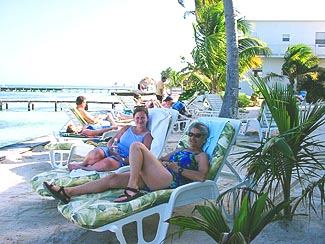 Day 8: Golf Carts and R&R
Day 8: Golf Carts and R&R
Dan and I had hoped to get in another dive before we left. We had scheduled a
two-tank dive for this day, but the winds had turned during the night and the swells outside the reef were
strong, too strong to go out. So, the Buddes decided that the kids would enjoy a morning cruising town in a
golf cart. I don’t know where they went, but they had a great time for about two hours. The rest of us
stayed close to the beach and pool.
About one o’clock we got word from Barefoot Divers that the seas had calmed
enough that diving outside the reef was possible. Dan and I got ready and went out to a spot called
Cypress Canyons. The
sea still treated the boat roughly in the 6'-7'
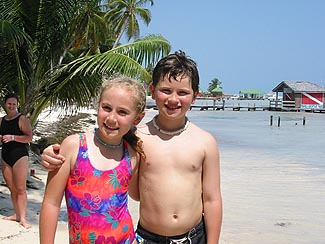 swells, but we got down and had a good dive (saw the biggest southern sting ray I’ve ever seen—a
span of seven to eight feet!). Coming up, both Dan and I succumbed to the effects of the malaria medication
we’d been taking: nausea hit us both and by the time we got back to the dock for our interval rest
between dives, we both agreed that going out again would be the end of us. (Fellow divers: This is the second
time I’ve been nauseous from diving. It’s the second time I’ve taken malaria medication. I
won’t do both again on the same trip. I’ll bet many of you out there have had the same experience.)
swells, but we got down and had a good dive (saw the biggest southern sting ray I’ve ever seen—a
span of seven to eight feet!). Coming up, both Dan and I succumbed to the effects of the malaria medication
we’d been taking: nausea hit us both and by the time we got back to the dock for our interval rest
between dives, we both agreed that going out again would be the end of us. (Fellow divers: This is the second
time I’ve been nauseous from diving. It’s the second time I’ve taken malaria medication. I
won’t do both again on the same trip. I’ll bet many of you out there have had the same experience.)
We walked down the beach to
Ramon’s Village for dinner
(underwhelming, though a nice setting. Is there no place on Ambergris where the food is something to rave
about and someone knows how to make a good margarita??). We finished off the evening with more Shanghai rummy.
Day 9: Good-Bye to Belize
The airport in downtown San Pedro is home to two airlines (Tropic Air and Maya
Air). We packed leisurely and piled into an overstuffed taxi to catch our noon flight to Belize International
Airport. The flight over the water and surrounding cayes was a sweet way to end the trip. From there, it was
a short hop to Miami and a long flight to Denver where we found the temperature 80 degrees less than when we
took off from San Pedro. We were back to the reality of winter in Colorado.

Sunrise at Banana Beach. What a way to start the day in Belize!

 MACAL RIVER JUNGLE CAMP
MACAL RIVER JUNGLE CAMP
 amidst thick jungle just above the river. (Michael and Cindy’s casita was the one you see
“behind the palm fronds” on
the web site for the Camp.) We ate breakfast and dinner each day in the open air dining area
and enjoyed a campfire each night. The flush toilets and hot showers were a greatly appreciated
touch of civilization. We were very comfortable, ate well, and drank very cold sodas and
Belikins. Dosio, his
wife, Francelia, and a small staff provided for our every comfort and helped make arrangements
for our daily activities.
amidst thick jungle just above the river. (Michael and Cindy’s casita was the one you see
“behind the palm fronds” on
the web site for the Camp.) We ate breakfast and dinner each day in the open air dining area
and enjoyed a campfire each night. The flush toilets and hot showers were a greatly appreciated
touch of civilization. We were very comfortable, ate well, and drank very cold sodas and
Belikins. Dosio, his
wife, Francelia, and a small staff provided for our every comfort and helped make arrangements
for our daily activities.
 Day 1: Canoeing the Macal River to San Ignacio
Day 1: Canoeing the Macal River to San Ignacio days, it dried and continued to work as though nothing had happened. (Nikons really are good
cameras!)
days, it dried and continued to work as though nothing had happened. (Nikons really are good
cameras!)
 Day 2: Barton Creek Cave
Day 2: Barton Creek Cave east of San Ignacio) we passed through a huge citrus ranch (oranges and grapefruit) and drove through a
community of small, self-sustaining farms with horses and buggies out front. In the middle of the farms
was a church holding services for families in traditional dress that you expect to see in the Amish areas
of Pennsylvania, Ohio, and Indiana. In the jungles of Belize, it was surprising.
east of San Ignacio) we passed through a huge citrus ranch (oranges and grapefruit) and drove through a
community of small, self-sustaining farms with horses and buggies out front. In the middle of the farms
was a church holding services for families in traditional dress that you expect to see in the Amish areas
of Pennsylvania, Ohio, and Indiana. In the jungles of Belize, it was surprising.
 Day 3: Bicycling to Xunantunich and More
Day 3: Bicycling to Xunantunich and More of Guatemala and nearly back to San Ignacio.
of Guatemala and nearly back to San Ignacio.
 Day 4: The Belize Zoo and a
Boat Ride to Ambergris Caye
Day 4: The Belize Zoo and a
Boat Ride to Ambergris Caye worth the price of admission. Nearby are two restaurants worth stopping at for lunch: Cheers (with scores
of T-shirts hanging from the ceiling) and
JB’s where we stopped.
worth the price of admission. Nearby are two restaurants worth stopping at for lunch: Cheers (with scores
of T-shirts hanging from the ceiling) and
JB’s where we stopped.
 Day 5: Exploring San Pedro
Day 5: Exploring San Pedro of sand like the one in front of Banana Beach to wide, clean white sand beaches like those in front of
isolated Captain Morgan’s Retreat, the
posh Victoria House, and the good looking
Villas at Banyan Bay. However,
narrow beach or wide, we were able to walk to town along the shoreline, passing more diving docks than
I’ve seen on any beach anywhere, some restaurants on piers over the water, large resorts and small
hotels, and private beach front homes all the way to town. We looked through shops in town and did some
food shopping for breakfasts and snacks.
of sand like the one in front of Banana Beach to wide, clean white sand beaches like those in front of
isolated Captain Morgan’s Retreat, the
posh Victoria House, and the good looking
Villas at Banyan Bay. However,
narrow beach or wide, we were able to walk to town along the shoreline, passing more diving docks than
I’ve seen on any beach anywhere, some restaurants on piers over the water, large resorts and small
hotels, and private beach front homes all the way to town. We looked through shops in town and did some
food shopping for breakfasts and snacks.
 Day 6: Water Play
Day 6: Water Play and at least one spotted ray. Michael got a photo of a huge eel and a small nurse shark, as well as barracuda
and schools of smaller fish. Years of fishermen cleaning fish in this shallow are just inside the reef and
throwing the unwanted parts overboard attracted the rays and sharks who have made a habit of coming for food
here. The same happened in Cayman Islands to create Sting Ray City.
and at least one spotted ray. Michael got a photo of a huge eel and a small nurse shark, as well as barracuda
and schools of smaller fish. Years of fishermen cleaning fish in this shallow are just inside the reef and
throwing the unwanted parts overboard attracted the rays and sharks who have made a habit of coming for food
here. The same happened in Cayman Islands to create Sting Ray City.
 Day 7: Bicycling the Island
Day 7: Bicycling the Island the hand-pulled ferry across a lagoon inlet to the “north side” where the number of homes and
businesses thin out dramatically. We rode about three miles to where the road led to Captain Morgan’s
Retreat after which there’s not much more to see and the road slowly deteriorates.
the hand-pulled ferry across a lagoon inlet to the “north side” where the number of homes and
businesses thin out dramatically. We rode about three miles to where the road led to Captain Morgan’s
Retreat after which there’s not much more to see and the road slowly deteriorates.
 Day 8: Golf Carts and R&R
Day 8: Golf Carts and R&R swells, but we got down and had a good dive (saw the biggest southern sting ray I’ve ever seen—a
span of seven to eight feet!). Coming up, both Dan and I succumbed to the effects of the malaria medication
we’d been taking: nausea hit us both and by the time we got back to the dock for our interval rest
between dives, we both agreed that going out again would be the end of us. (Fellow divers: This is the second
time I’ve been nauseous from diving. It’s the second time I’ve taken malaria medication. I
won’t do both again on the same trip. I’ll bet many of you out there have had the same experience.)
swells, but we got down and had a good dive (saw the biggest southern sting ray I’ve ever seen—a
span of seven to eight feet!). Coming up, both Dan and I succumbed to the effects of the malaria medication
we’d been taking: nausea hit us both and by the time we got back to the dock for our interval rest
between dives, we both agreed that going out again would be the end of us. (Fellow divers: This is the second
time I’ve been nauseous from diving. It’s the second time I’ve taken malaria medication. I
won’t do both again on the same trip. I’ll bet many of you out there have had the same experience.)

